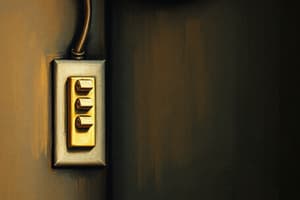Podcast
Questions and Answers
What is the purpose of electrical wiring safety codes and regulations?
What is the purpose of electrical wiring safety codes and regulations?
- To provide guidelines for electrical equipment manufacturers
- To ensure that electrical equipment is selected and installed correctly
- To regulate the cost of electrical equipment
- To protect people and property from electrical hazards (correct)
What is the most commonly used material for wiring interior electrical systems in buildings?
What is the most commonly used material for wiring interior electrical systems in buildings?
- Copper (correct)
- Brass
- Steel
- Aluminum
What is the purpose of bus bars in electrical systems?
What is the purpose of bus bars in electrical systems?
- To protect electrical equipment from power surges
- To connect electrical devices to a power source
- To distribute high currents throughout a building (correct)
- To provide insulation for electrical conductors
What is the de facto standard for color-coding of three-phase system conductors in the United States?
What is the de facto standard for color-coding of three-phase system conductors in the United States?
What is the purpose of electrical panels in a building?
What is the purpose of electrical panels in a building?
What is the earliest standardized method of wiring in buildings in North America?
What is the earliest standardized method of wiring in buildings in North America?
What type of wiring was used in North American residential wiring from the late 1960s to mid-1970s due to the rising cost of copper?
What type of wiring was used in North American residential wiring from the late 1960s to mid-1970s due to the rising cost of copper?
Which standard specifies requirements for the selection and installation of electrical equipment in Australia and New Zealand?
Which standard specifies requirements for the selection and installation of electrical equipment in Australia and New Zealand?
What type of cable is used only for extra-low voltage signal and control applications such as doorbell wiring?
What type of cable is used only for extra-low voltage signal and control applications such as doorbell wiring?
Flashcards are hidden until you start studying
Study Notes
Electrical Wiring: Safety Standards and Color Coding
-
Electrical wiring is the installation of cabling and devices such as switches, sockets, and light fittings in a structure.
-
Wiring is subject to safety standards for design and installation.
-
Allowable wire and cable types and sizes are specified according to the circuit operating voltage and electric current capability.
-
Wiring safety codes vary by locality, country, or region.
-
Wiring installation codes and regulations are intended to protect people and property from electrical shock and fire hazards.
-
In Australia and New Zealand, the AS/NZS 3000 standard specifies requirements for the selection and installation of electrical equipment.
-
In European countries, national standards follow an identical system of sections and chapters.
-
In the United Kingdom, wiring installations are regulated by the IEE Wiring Regulations, BS 7671: 2008, which are harmonized with IEC 60364.
-
In North America, the US National Fire Protection Association has published the National Electrical Code (NEC) since 1897.
-
Color coding of wires is mandatory in a typical electrical code.
-
In the United States, color-coding of three-phase system conductors follows a de facto standard.
-
Materials for wiring interior electrical systems in buildings vary depending on the requirements of the building.Overview of Electrical Wiring: Copper and Aluminum Conductors, Raceways and Cable Runs, Bus Bars, Electrical Panels, and Historical Wiring Methods
-
Residential electrical service usually consists of three twisted conductors, with one being a bare neutral conductor and the other two being insulated conductors for both two 180-degree out of phase 120 V line voltages.
-
Copper conductors are preferred over aluminum conductors due to their high electrical conductivity, tensile strength, ductility, creep resistance, corrosion resistance, thermal conductivity, and ease of installation.
-
Aluminum wire was used in North American residential wiring from the late 1960s to mid-1970s due to the rising cost of copper. However, it requires larger conductors than copper.
-
Bus bars are used for high currents distributed through a building, and each live conductor of such a system is a rigid piece of copper or aluminum, usually in flat bars.
-
Electrical panels are easily accessible junction boxes used to reroute and switch electrical services, and the term is often used to refer to circuit breaker panels or fuseboxes.
-
Squirrels, rats, and other rodents may gnaw on unprotected wiring, causing fire and shock hazards, which is especially true of PVC-insulated telephone and computer network cables.
-
The earliest standardized method of wiring in buildings in North America from about 1880 to the 1930s was knob and tube (K&T) wiring.
-
Armored cables with two rubber-insulated conductors in a flexible metal sheath were used as early as 1906.
-
Rubber-insulated cables become brittle over time due to exposure to atmospheric oxygen, so they must be handled with care and are usually replaced during renovations.
-
About 1950, PVC insulation and jackets were introduced, especially for residential wiring.
-
The simplest form of cable has two insulated conductors twisted together to form a unit, and such non-jacketed cables with two or more conductors are used only for extra-low voltage signal and control applications such as doorbell wiring.
-
Metal moulding systems with a flattened oval section consisting of a base strip and a snap-on cap channel were more costly than open wiring or wooden moulding but could be easily run on wall surfaces.
Studying That Suits You
Use AI to generate personalized quizzes and flashcards to suit your learning preferences.




